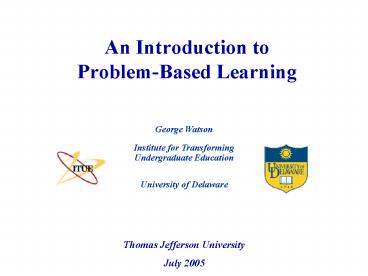An Introduction to Problem-Based Learning - PowerPoint PPT Presentation
Title:
An Introduction to Problem-Based Learning
Description:
Title: PowerPoint Presentation Author: George Watson Last modified by: George Watson Created Date: 6/14/2000 3:25:46 AM Document presentation format – PowerPoint PPT presentation
Number of Views:62
Avg rating:3.0/5.0
Title: An Introduction to Problem-Based Learning
1
An Introduction toProblem-Based Learning
George Watson
Institute for TransformingUndergraduate Education
University of Delaware
Thomas Jefferson University July 2005
2
What are the CommonFeatures of PBL?
- Learning is initiated by a problem.
- Problems are based on complex, real-world
situations. - All information needed to solve problem is not
initially given. - Students identify, find, and use appropriate
resources. - Students work in permanent groups.
3
PBL The Process
- Students are presented with a problem. They
organize ideas and previous knowledge. - Students pose questions, defining what they know
and do not know. - Assign responsibility for questions, discuss
resources. - Investigate learning issues.
- Reconvene, explore newly learned information,
refine questions.
4
Problem-Based Learning Cycle
Overview/Assessment
Problem, Project, or Assignment
Mini-lecture(only if needed!)
Group Discussion
Whole Class Discussion
Research
Preparation of Group Product
Group Discussion
5
A Typical Day in a PBL Course
6
Characteristics Neededin College Graduates
- High level of communication skills
- Ability to define problems, gather and evaluate
information, develop solutions - Team skills -- ability to work with others
- Ability to use all of the above to address
problems in a complex real-world setting
Quality Assurance in Undergraduate Education
(1994) Wingspread Conference, ECS, Boulder, CO.
7
Skills Used Frequently by Physics Bachelors in
Selected Employment Sectors, 1994
Source AIP Education and Employment Statistics
Division































